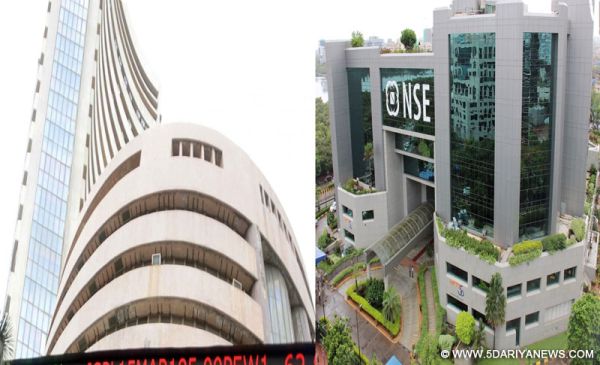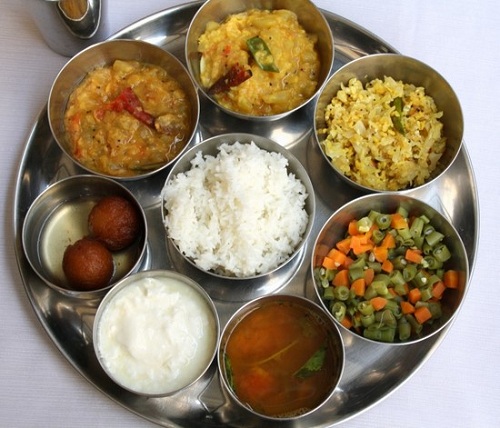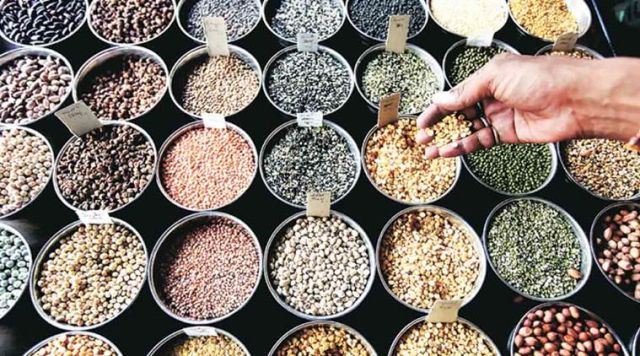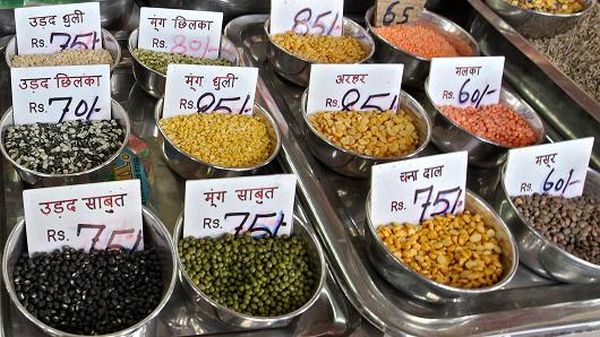
by admin | May 25, 2021 | Economy, Markets, News
 By Rituraj Baruah,
By Rituraj Baruah,
Mumbai : After reaching new landmarks in the last couple of trading sessions, the key Indian equity indices are likely to witness another eventful week (June 16-20), with major quarterly earnings and a key macro-economic data point, the Wholesale Price Index, due in the next few days.
According to market observers, further developments in the ongoing trade tensions between the US and China also would set the cues for the global markets.
“The markets next week would look forward to the earnings season as larger companies such as HUL (Hindustan Unilever), Bajaj group of companies will come out with their results,” said Devendra Nevgi, founder and Principal Partner at Delta Global Partners.
According to Geojit Financial Services’ Head of Research, Vinod Nair: “Market is expecting 19 per cent growth in PAT (profit after tax) for Sensex index stocks and 14.7 per cent for Nifty50 index stocks in Q1, FY19 compared to a washout in last quarter.”
“From here on market trend will largely depend on progress of results season,” he said.
Gaurav Jain, Director of Hem Securities said: “We will continue to see stock-specific approach as heavyweights like HDFC Bank, Hindustan Unilever, Ashok Leyland, Zee Entertainment, Ultratech Cement, MindTree, Bajaj Finance, and Kotak Mahindra Bank are scheduled to report their quarterly earnings.”
On the macro front, the government will announce wholesale price inflation (WPI) for June 2018 on Monday, July 16, Jain added.
Further, on the global side, markets would be hoping for easing of trade related issues between the US and China, said Sanjeev Zarbade, Vice President for Research at Kotak Securities.
Noting the significance of oil prices, Zarbade said: “Crude oil prices have corrected a bit and further softening in prices would be positive for global markets”.
In the week ended Friday, fall in crude oil prices was a major factor for the positive trend in the global and domestic equity markets.
As per Delta Global Partners’ Nevgi, the fall in crude prices and weaker US dollar would help the sentiments in the rupee market.
On Friday, the Indian rupee closed at 68.53, strengthening by 35 paise from its previous week’s close of 68.88 per greenback.
Talking on the investor sentiments in the Indian equity market, Nevgi told IANS,the support comes from domestic investors as foreign ones continue to be net sellers.
In the week gone by, provisional figures from the stock exchanges showed that foreign institutional investors sold scrip worth Rs 1,801.65 crore, while the domestic institutional investors purchased stocks worth Rs 2,288.08 crore.
During the upcoming week, Deepak Jasani, Head of Retail Research at HDFC Securities feels, “further upsides are likely, once the immediate resistance band of 11,078-11,171 (Nifty50) is taken out.”
The level of 10,893 points would be a crucial support for the Nifty50 on the National Stock Exchange, he added.
On Friday, the Nifty50 closed at 11,018.90 points — up 246.25 points or 2.29 per cent — from its previous week’s close.
The Sensex on BSE rose by 883.77 points or 2.48 per cent to close at 36,541.63 points on a weekly basis.
On Thursday, the barometer 30-scrip Sensex touched a record high of 36,699.53 points, only to surpass the level the very next day and set a fresh all-time high of 36,740.07 points.
It had also set a new closing high of 36,548.41 points on Thursday.
With another eventful week expected to follow, these instances of fresh benchmarks and landmarks, may not end here.
(Rituraj Baruah can be contacted at rituraj.b@ians.in )
—IANS

by admin | May 25, 2021 | Commodities, Commodities News, Economy, Markets, News
 New Delhi : A major spurt in food and fuel prices in the country pushed the wholesale price index (WPI) for May to 4.43 percent, to nearly double over the 2.26 percent registered in May last year and higher than the 3.18 percent recorded in April, 2018, Commerce Ministry data showed on Thursday.
New Delhi : A major spurt in food and fuel prices in the country pushed the wholesale price index (WPI) for May to 4.43 percent, to nearly double over the 2.26 percent registered in May last year and higher than the 3.18 percent recorded in April, 2018, Commerce Ministry data showed on Thursday.
Earlier this week, Central Statistics Office data showed that the consumer price index (CPI), or retail inflation, in May had touched 4.87 percent.
Citing risks to inflation mainly from rising global crude prices, the Reserve Bank of India (RBI) last week raised its key lending rate by 25 basis points to 6.25 percent for the first time in over four years. The RBI has a median retail inflation target rate of 4 per cent.
The WPI Food Index, consisting of ‘Food Articles’ from Pri’ary Articles group and ‘Food Prod‘ct’ from Man’factured Products group, increased from 0.67 per cent in April 2018, to 1.12 per cent last month.
Expenses during the month under consideration on primary articles, which constitute 22.62 per cent of the WPI’s total weightage, rose by 3.16 per cent, from a fall of
(-)1.71 per cent in May 2017.
Among primary articles, food, which has a weightage of 15.26 per cent in the index, edged up last month by 1.60 per cent from a deceleration of (-)2.13 per cent reported for the same month last year.
The cost of fuel and power, which commands a 13.15 per cent weightage in the index, increased at a fast pace of 11.22 per cent during the month in review, from a growth of 7.85 per cent in April 2018.
Reacting to the WPI numbers, industry body Assocham urged policymakers to keep a check on petrol and diesel prices as these could “significantly impact import bills which may subsequently have an effect on exchange rates.”
“Besides, it might also negatively impact input prices for the industry which has already started feeling the pressure on its profitability,” Assocham Secretary General D.S. Rawat said in a statement.
“Rising crude prices would not only affect headline inflation but would also put pressure on price levels as the twin deficit goes up, thereby impacting government’s plan to’increase rural spending and minimum support price for farmers ahead of general elections next year as it would exacerbate price pressures, and is likely to blow out the fiscal deficit target,” he added.
—IANS

by admin | May 25, 2021 | Commodities, Commodities News, Economy, Markets, News
 New Delhi : Wholesale price-indexed (WPI) inflation in India during March softened marginally at 2.47 per cent from 2.48 per cent in the previous month, official data showed here on Monday.
New Delhi : Wholesale price-indexed (WPI) inflation in India during March softened marginally at 2.47 per cent from 2.48 per cent in the previous month, official data showed here on Monday.
According to the Commerce Ministry data, the WPI inflation in March 2017 was more than double at 5.11 per cent.
—IANS

by admin | May 25, 2021 | Business, Commodities, Commodities News, Economy, Finance, Markets, Medium Enterprise, News, SMEs
 New Delhi : Lower food prices pulled India’s annual rate of inflation based on wholesale prices to a three-month low of 3.58 per cent in December, official data showed on Monday.
New Delhi : Lower food prices pulled India’s annual rate of inflation based on wholesale prices to a three-month low of 3.58 per cent in December, official data showed on Monday.
As per data furnished by the Ministry of Commerce and Industry, the Wholesale Price Index (WPI) -based inflation, with the revised base year of 2011-12, was 3.93 per cent in November.
However, the WPI-based inflation rate in December 2017 was higher than 2.10 per cent reported for the corresponding month of the previous year.
“Build-up inflation rate in the financial year so far was 2.21 per cent compared to a build-up rate of 3.71 per cent in the corresponding period of the previous year,” the ministry said in a statement.
On a sequential basis, the expenses on primary articles, which constitute 22.62 per cent of the WPI’s total weightage, edged higher by 3.86 per cent, from an increase of 5.28 per cent in November.
The prices of food articles rose by 4.72 per cent from an acceleration of 6.06 per cent in the previous corresponding month.
On a year-on-year (YoY) basis, food prices in December rose by 4.72 per cent from a rise of only 0.07 per cent.
In terms of individual items, onion prices soared higher by 197.05 per cent, whereas for potatoes it plunged by (-)8.40 per cent.
In contrast, the overall vegetable prices in November rose by 56.46 per cent, against a fall of (-)26.88 per cent in the same month a year ago.
Further, the data revealed that wheat became cheaper by (-)8.47 per cent on YoY basis and the prices of pulses came down by (-)34.60 per cent, but paddy became dearer by 3.19 per cent.
On the other hand, protein-based food items such as eggs, meat and fish became expensive by 1.67 per cent during the month.
Prices of the other major group under the WPI, manufactured products, which comprise nearly 64.23 per cent of the index, recorded a 2.61 per cent rise.
The sub-category of manufactured food products registered a decline of (-)0.23 per cent.
Fuel and power prices accelerated by 9.16 per cent.
Product-wise, the price of high-speed diesel rose by 12.68 per cent during December while that of petrol climbed by 8.80 per cent and for LPG by 21.14 per cent.
According to industry body Ficci, moderation in WPI-based inflation “has come primarily owing to lower food prices”.
“The easing of inflation is a positive sign and continued efforts of government to strengthen food supply mechanism can help in bringing down food inflation further,” said Ficci President Rashesh Shah.
“As the inflation numbers are being driven largely on account of supply side factors, we urge the Reserve Bank of India to calibrate its monetary policy stance giving equal weightage to growth consideration.”
Another industry chamber — Assocham — stated that despite likely seasonal softening of prices, inflation is expected to “remain high till first quarter of FY19”.
“The policymakers need to take care of the continuous rise in the petrol and high speed diesel prices due to rise in global crude oil prices which may have an impact on import bills and subsequent impact on exchange rates,” said Assocham Secretary General D.S. Rawat.
“Besides, it may have negative impact on input prices for industry which has already started to feel pressure on its profitability.”
Ratings agency ICRA’s Principal Economist Aditi Nayar was quoted in a statement as saying that: “The divergence in the sequential trend in the CPI and WPI inflation in December 2017 was driven by food inflation, and the impact of the higher housing inflation, which was limited to the CPI.”
“The dip in the inflation for primary food articles in the WPI for December 2017 may signal some correction in the CPI inflation for food items in the ongoing month.”
Kotak Mahindra Bank’s Senior Economist Upasna Bhardwaj said: “The (Reserve Bank of India) MPC (monetary policy committee) may prefer to maintain a status quo, at least through 1HCY18, as it gets more clarity on monsoon and sustainability of high crude oil prices post the winter squeeze.”
Inflationary risks had forced the RBI to hold its key lending rate unchanged for the third time in a succession at 6 per cent in its penultimate bi-monthly monetary policy review of the fiscal last month.
The RBI is expected to conduct the final monetary policy review for 2017-18 in February.
—IANS

by admin | May 25, 2021 | Business, Commodities, Commodities News, SMEs
 New Delhi : An exponential rise in food and fuel prices especially those of onions and diesel pushed India’s annual rate of inflation based on wholesale prices higher to 3.93 per cent for November, official data showed on Thursday.
New Delhi : An exponential rise in food and fuel prices especially those of onions and diesel pushed India’s annual rate of inflation based on wholesale prices higher to 3.93 per cent for November, official data showed on Thursday.
According to data from the Ministry of Commerce and Industry, the wholesale price index (WPI) accelerated to 3.93 per cent in November from 3.59 per cent during October and 1.82 per cent during the corresponding month of 2016.
Reacting to the data, India Inc. said the rise in inflation was mainly driven by vegetables, onions, eggs, meat and fish, minerals, petrol and high speed diesel due to a decline in production and the resultant fall in the supply side.
On a sequential basis, the expenses on primary articles, which constitute 22.62 per cent of the WPI’s total weightage, edged higher by 5.28 per cent, from an increase of 3.33 per cent in October.
The prices of food articles rose by 6.06 per cent from a rise of 4.30 per cent in October.
In terms of food prices, the YoY (Year-on-Year) wholesale inflation rate for onions was higher by 178.19 per cent, whereas for potatoes it plunged by (-)40.73 per cent.
In contrast, the overall vegetable prices in November rose by 59.80 per cent, against a fall of (-)17.31 per cent in the same month a year ago.
As per data, wheat became cheaper by (-)5.75 per cent on YoY basis and the prices of pulses came down by (-)35.48 per cent, but paddy became dearer by 2.90 per cent.
On the other hand, protein-based food items such as eggs, meat and fish became expensive by 4.73 per cent during the month under review.
Prices of the other major group under the WPI, manufactured products, which comprise nearly 64.23 per cent of the index, recorded a 2.61 per cent rise.
The sub-category of manufactured food products registered a rise of 0.47 per cent.
Similarly, fuel and power prices accelerated by 8.82 per cent.
Product-wise, the price of high-speed diesel rose by 11.63 per cent during November while that of petrol climbed by 10.57 per cent and for LPG by 31.30 per cent.
Expressing concern over the rise in wholesale inflation, industry body Assocham’s Secretary General D.S. Rawat said: “The continuous increase in the prices of petrol and high speed diesel due to rise in prices of crude oil globally have to be taken care of by the policy makers since it may have impact on import bills and subsequent impact on exchange rates.”
“… it may have negative impact on input prices for the industry which has already started to feel the pressure on its profitability.”
—IANS





